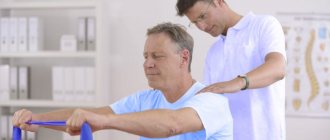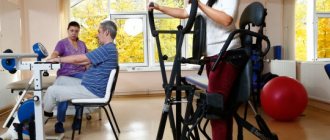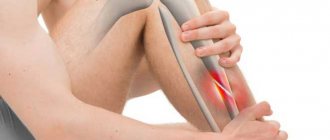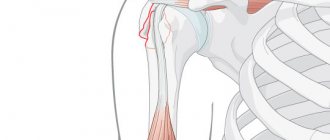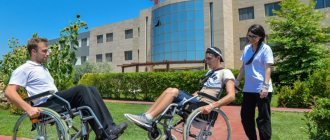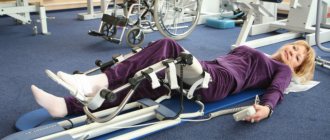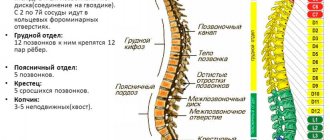In most patients, the wrist joint does not restore its physiological mobility after a fracture and long-term wearing of a plaster cast. Pain, edema syndrome, contracture, ankylosis, etc. may persist for a long time. Approximately 30% of patients develop carpal tunnel syndrome after such an injury. This disease causes persistent pain and a feeling of numbness in the fingers. With carpal tunnel syndrome, it is impossible to perform small movements with the fingers.
Rehabilitation after a fracture of the wrist joint includes a number of therapeutic measures aimed at:
- complete restoration of microcirculation of blood and lymphatic fluid at the site of traumatic tissue damage;
- regulation of metabolic and regeneration processes in order to accelerate damage recovery;
- stimulating effect on the process of callus formation, due to which bone fusion occurs in the fracture area;
- reducing the risk of developing ankylosis, the formation of coarse scar tissue and contracture with a sharp limitation of the amplitude of mobility in this bone joint;
- restoration of the working capacity of the muscle tone that ensures mobility in the joint and hand;
- restoration of fine motor skills and reflexes;
- preventing the risk of relapse of pathology.
A special course is used for rehabilitation after a displaced fracture of the wrist joint, since with such an injury there is a high probability of compression of the nerve fiber, which will lead to disruption of innervation. Soft tissues, muscles and blood supply will be affected. The capillary bed will not cope with tissue trophism and this will lead to partial degeneration, including tissue of the wrist joint.
Rehabilitation of the hand after a fracture of the wrist joint includes the following types of therapeutic effects:
- therapeutic exercises – allows you to increase the amplitude of mobility, increase muscle tone;
- osteopathy is necessary in order to enhance microcirculation of blood and lymphatic fluid;
- massage increases tissue elasticity and eliminates the risk of scar formation;
- acupuncture is used to start the process of accelerated tissue regeneration;
- physiotherapy and laser exposure are necessary to improve the condition of bone tissue and muscles, cartilage and connective fibers.
If you need to undergo full rehabilitation after suffering a fracture of the wrist joint, you can contact our manual therapy clinic in Moscow. Your first appointment with an osteopath, chiropractor or orthopedist will be completely free. Then the doctor will develop an individual recovery course for you. You will be able to independently decide whether you will carry out it yourself or entrust this process to the doctors of our clinic.
Contracture of the wrist joint after a fracture of the radius
Partial contracture of the wrist joint after a fracture occurs in every patient who wore a cast for 30 to 40 days. With prolonged immobilization, fibrous tissue begins to form between the bones. It reduces mobility and, in the absence of timely treatment, leads to the development of complete contracture of the wrist joint after a fracture of the radius, which prevents any movement.
In order to exclude contracture of the wrist joint after a fracture, before treating the injury, you need to make sure that the blood supply and innervation were not disrupted when applying a plaster cast.
Contracture manifests itself in the fact that a person cannot fully bend the hand, rotate it, straighten it, etc. After removing the plaster, it is necessary to begin restorative treatment as quickly as possible so that there are no prerequisites for the formation of ankylosis and contracture.
Diet during rehabilitation
In order for the bones to heal well during rehabilitation and become strong, in addition to rehabilitation, you must follow a diet. The diet should contain foods that help stimulate the body's production of its own collagen.
The menu should include:
- vegetables and fruits,
- greens that contain a vitamin-mineral complex,
- It is necessary to provide the body with the microelement calcium,
- eat different types of cabbage (cauliflower, broccoli, cabbage),
- fish,
- dairy products.
In addition to proper nutrition, it is useful to do handicrafts: knitting, embroidery, sewing, sawing or burning.
Numbness of the fingers after a wrist fracture
Constant or periodic numbness of the fingers after a fracture of the wrist joint indicates that during the healing of the damaged bone tissue, the nerve fiber was pinched in one of the three canals.
The wrist joint is complex in its anatomical structure. It includes the epiphyses of four bones: the radius, scaphoid, lunate and triquetrum. Between them there are three channels in which nerves and blood vessels pass:
- cubital canal - here passes the ulnar nerve and blood vessels from the groove of the ulna;
- radial canal - the radial flexor tendon passes through and the radial artery, which is responsible for the blood supply to the soft tissues of the hand, is based here;
- carpal tunnel - in two synovial sheaths the median nerve and the artery supplying it with blood are located.
Numbness may be due to the fact that scar tissue has formed in one of the canals or calcium salts have been deposited while wearing a cast. Thus, with compression of the nerve fiber, innervation numbness of the fingers occurs. If all five fingers go numb, then most likely this is due to a violation of the blood supply. In any case, numbness in the fingers after a fracture of the wrist joint requires a long course of recovery.
Contraindications
It is impossible to develop the hand after a fracture of the wrist that occurs with displacement, when parts of the bones are close to the vessels through which blood flows or nerves. At the same time, exercise therapy exercises during rehabilitation after a fracture of the hand are prohibited under the following conditions:
- the victim is in shock;
- severe blood loss;
- risk of recurrent bleeding;
- presence of severe pain;
- strongly expressed inflammatory process;
- diseases for which physical activity is prohibited.
If you do not follow these contraindications, this may cause complications.
Treatment after a wrist fracture
There are several stages of treatment after a fracture of the wrist joint: early, middle and late. In the early period, it is necessary to fix the joint and limit its mobility. To do this, a plaster cast is applied for 30–40 days, depending on the complexity of the injury. If the fracture is displaced, then surgical intervention can be performed in the early period to restore the normal position of all bone fragments.
In the middle period of treatment, the patient is recommended to use drugs that enhance the process of bone tissue regeneration.
The late period begins at the moment the plaster is removed. A control X-ray is taken, which shows the degree of callus formation and the opportunity to begin rehabilitation.
If all the bones have already fused, then physical therapy, massage, physiotherapy, etc. are prescribed for treatment.
When can you start rehabilitation?
The sooner you start rehabilitation, the more effective and faster the treatment will be and the better the result will be. For this reason, the simplest restorative procedures begin a few days after the application of the plaster, and a full course of rehabilitation begins no later than one and a half to two weeks after its removal, but not before complete fusion of the bones.
The treatment process itself is very individual and depends on the patient’s age, his physiological characteristics, and the severity of the injury. Therefore, all exercises and procedures must be carried out regularly, consistently and in stages.
Rehabilitation should not be neglected. Even after the plaster is removed and the bone heals, sometimes a very serious problem remains - insufficient mobility of the damaged limb. Due to the long period of immobilization, many patients note that they cannot bend their fingers into a fist. Such problems do not go away on their own. Only after a course of physiotherapy, massage, and special exercises can the normal functioning of the hand be restored.
Development and restoration of the hand after a fracture of the wrist joint
The initial development of the hand after a wrist fracture begins immediately after the cast is removed. Pain and swelling may still persist. Exercise can be uncomfortable. It is very important that during the development of the wrist joint after a displaced fracture, no harm is caused to the patient’s health. It is not uncommon for the wrist joint to be developed after a fracture without medical supervision. And at the same time, a repeated violation of the integrity of the bone tissue occurs.
It is very important to understand that after the fracture heals, the degree of stress in the bone tissue changes. During the entire adaptation period, the process of uniform distribution of the applied mechanical load is disrupted. This leads to the fact that, if performed incorrectly during recovery after a fracture of the wrist joint, cracks appear and re-application of a plaster cast is required.
Restoration of the wrist joint after a broken arm should only be performed in specialized clinics. In Moscow, for these purposes, you can visit a free appointment with an orthopedist at our manual therapy center. The doctor will review your medical documents, conduct an examination, assess the degree of impairment of bone joint mobility and develop an individual treatment program. You can then decide whether to implement it yourself or attend sessions at our clinic.
It is usually proposed to carry out a full course, during which the risk of developing contracture, carpal tunnel syndrome, numbness of the fingers, etc. will be eliminated. When the first signs of ankylosis appear, it is necessary to begin treatment, since this is the first stage in the formation of contracture.
Physical therapy exercises
For a full life, it is very important to normalize the functions of the hand. This requires the organization of proper rehabilitation after traumatic effects on the hands, aimed at restoring working function.
After the process of removing the cast, patients usually notice that the arm feels as if it is not its own. This phenomenon is explained by the fact that the limb was without movement for a long time, the muscles became weak, and blood flowed poorly into the tissues.
In this case, the bone parts are restored, but the functions of the limb are fully utilized. For complete recovery during rehabilitation, it usually takes 30 to 60 days - see table above.
Rehabilitation complex after plaster removal
Such rehabilitation exercises should be selected for the functionality of the hand during rehabilitation after a wrist fracture with a gradual increase and consisting of active and passive loads, taking into account individual physical characteristics and characteristics of the injury.
| Type of exercise therapy for a fracture of the arm in the wrist joint | Therapeutic effect |
| Breathing exercises | Pain relief |
| Saturation of tissues with oxygen | |
| Acceleration of regeneration of a damaged joint | |
| Relaxation of the central nervous system | |
| Ideomotor exercises | Maintaining muscle tone |
| Improvement of psycho-emotional state | |
| Regaining control of the damaged area | |
| Isometric muscle tension | Maintaining muscle tone |
| Improving blood circulation in the hand | |
| Pain relief |
For example, the following exercises are recommended after removing a cast from an injured arm:
- clench your fingers into a fist;
- hold the palmar part in the “scissors” position;
- connect the thumb with the index finger in the form of a ring, while relaxing other parts of the upper limbs;
- keep your palms in the “goat” position;
- connect the thumb, index, middle and ring fingers in a half-ring, leaving the outermost one aside;
- fold the limbs of the injured hand into a “victory” sign and pull the upper ones back;
- clasp the upper parts of the two palms in the “goat” position and stretch in opposite directions;
- intertwine the inner parts of the brushes and push them away;
- clench the injured hand into a fist, stick out your index finger and pull it up with the other hand;
- press each finger in turn on a hard surface;
- make different shapes from matches;
- tie shoelaces;
- fasten the hooks.
You can perform exercises in water: lift small objects from the bottom of the basin, for example, coins or small buttons.
Rehabilitation exercises at home
- The very first rehabilitation exercises for restoring a hand at home can be considered training with plasticine. Taking ordinary plasticine in your hand, you should try to warm it up by kneading it with your fingers. This exercise should be performed several times a day for a month.
- The following exercise accelerates the blood and makes it circulate faster through the problem limb. To perform it, you need to sit down, stretch your arms in front of you, then turn your clenched palms to the right and left sides slowly and without jerking.
- To relieve swelling, you can use an ordinary tennis ball. You just have to throw it at the wall and then try to catch it. When performing, you cannot overload the limb too much.
- Another exercise to relieve swelling is performed with three small tennis balls, they are placed in the palm of your hand, you must try to move them with your fingers, which will contribute to the correct fusion of bones.
Important ! These actions for rehabilitation after a fracture of the arm in the wrist joint stimulate blood circulation in the limb, promote the outflow of lymph and provide the cells with the necessary nutrients, including collagen, which affects the rate of bone fusion.
Measures to restore the hand after removing the cast
Restoring the hand after removing the cast includes a whole range of measures - exercise therapy, massage, balanced nutrition, physiotherapeutic procedures and even acupuncture. They are prescribed in each specific case by the attending physician, taking into account the individual characteristics of the patient. It is very important to follow these instructions carefully and regularly. Only in this case will it be possible to fully restore the functionality of the damaged limb.
Rehabilitation physical therapy
A mandatory stage of rehabilitation after a fracture of the hand is physical therapy. It is aimed at restoring range of motion and strengthening the muscles and ligaments of the wrist, preventing the appearance of arthrosis and contracture.
You can begin full-fledged exercises approximately two weeks after removing the cast, with the exception of rehabilitation after a displaced fracture of the hand. They must initially be completed under the supervision of a qualified instructor. The duration of the course depends on the severity of the injury and the patient’s health condition and can take from several weeks to six months.
However, simple exercises can be performed independently within two weeks after applying the plaster. During this period, it is recommended to move the joints that are not fixed with a plaster cast, bend your fingers and perform light circular movements with them. This will keep your muscles toned.
There is also a whole set of simple recommendations on how to develop a finger after a fracture.
The next stage of rehabilitation with the help of exercise therapy begins after the removal of the cast. Its main goal is to restore ligament mobility, muscle strength and coordination of movements.
Squeezing and unclenching exercises will help restore strength to muscles that have weakened from prolonged inactivity. At first, you can use a regular foam sponge for this purpose, and eventually move on to an expander. Exercises in water and massage also give good results.
At the final stage, the main task of exercise therapy is to eliminate the consequences of the fracture. The course of therapy includes strength exercises, occupational therapy and outdoor games.
Physiotherapy during rehabilitation
After a full course of physiotherapeutic procedures:
- pain is reduced;
- callus is formed;
- motor activity is restored;
- swelling disappears;
- blood flow accelerates;
- tension is relieved;
- Contracture and muscle atrophy are prevented.
Physiotherapy helps to significantly reduce the risk of complications (this can include stiffness of the hand, damage to nerves and blood vessels, and the appearance of false joints).
The course of physiotherapy is prescribed by the doctor individually, taking into account the patient’s condition and the characteristics of the injury, but in general terms it may include:
- magnetic therapy (restores muscle reactivity and strength);
- UHF (reduces pain and swelling, therefore, as a rule, it is prescribed at the initial stage);
- paraffin baths;
- infrared laser therapy;
- electrophonoresis with novocaine and bromine preparations to relieve severe pain;
- balneotherapy with bromine, iodine, pine needles, turpentine;
- calcium electrophoresis;
- ultraviolet irradiation;
- manual therapy to restore innervation, blood circulation, joint mobility;
- interference currents for resorption of hematomas and edema;
- acupuncture.
Restorative massage
A full recovery massage after removing the bandage is usually carried out by a specialist who will help develop the muscles and correctly distribute the load after a fracture. He usually uses drainage massage aimed at restoring lymph flow and blood circulation. Classic massage movements move from the neck and shoulder to the hand and include techniques such as stroking, rubbing with pressure, kneading with oils or decongestants, and tapping.
At this stage, massage often causes pain, so the massage should be performed by a qualified specialist who will gradually relieve pain and restore the functionality of the hand.
In addition, massage is an excellent means of preparing an injured limb for exercise therapy and subsequent physiotherapeutic procedures.
Acupuncture for hand rehabilitation
Acupuncture, or acupuncture, along with other eastern practices, is aimed at restoring natural blood flow and relieving pain in injured limbs. It accelerates metabolic processes, restores muscle tone, stops trophic processes, and reduces pain. In general, it has a restorative and healing effect on the body.
It is worth noting that from the point of view of Chinese medicine, complete rehabilitation of the hand after a fracture includes both acupuncture, acupressure and regular massage, magnetic vacuum therapy, herbal medicine and proper nutrition.
As a result, the elasticity of muscles and ligaments, joint mobility are restored, stagnant and atrophic processes are eliminated, and self-healing mechanisms are activated in the body.
This practice is auxiliary and cannot replace a course of physiotherapy or exercise therapy.
Nutrition during the recovery period
Treatment of a fractured hand after removal of the cast also includes diet therapy. To restore bone tissue, the diet should include foods containing the required amount of protein, vitamins and minerals.
First of all, we are talking about calcium. They are rich in dairy products, bran bread, cereals, salmon, spinach, sesame seeds, cabbage, and nuts.
Vitamin D facilitates the rapid absorption of calcium in the body. However, it is not always necessary to drink fish oil or take special vitamin preparations. You can increase your vitamin D production by regular walks in sunny weather.
Phosphorus is directly involved in the formation of bone tissue, so you can include liver, cheese, pumpkin, and caviar in the menu.
Diagnostics
Since the fracture has signs similar to a bruise or sprain, only a specialist can make a diagnosis.
Depending on the signs of the disease, you can contact a doctor:
- to a surgeon or traumatologist - if the patient has a mechanical injury;
- rheumatologist, therapist, urologist or dermatologist - for arthrosis, arthritis or bursitis.
Diagnostics include:
- Medical examination;
- X-ray of the hand;
- Ultrasound.
For an intra-articular fracture, an MRI is prescribed.
If necessary, additional examination is carried out.
First aid consists of the following:
- Anesthesia;
- Immobilization of the hand by applying a splint to the palmar surface and bandaging the hand;
- Hospitalization in the inpatient department (trauma department).

